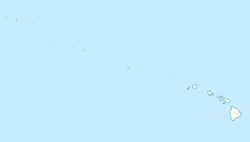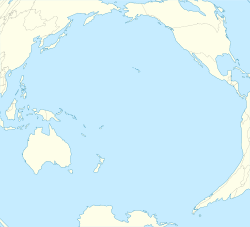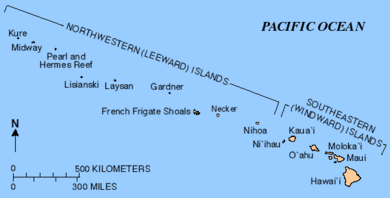Midway Atoll facts for kids
Quick facts for kids
Unincorporated U.S. Territory
Midway Islands
|
||
|---|---|---|
|
Island
|
||
|
||
| Anthem: "The Star-Spangled Banner" | ||
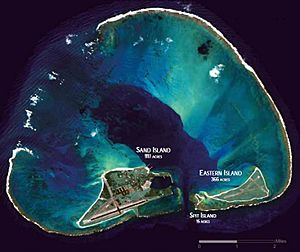
Satellite image of Midway Atoll
|
||
| Country | ||
| Country subdivision | United States Minor Outlying Islands | |
| Claimed by U.S | August 28, 1867 | |
| Area | ||
| • Total | 25.6 sq mi (66.3 km2) | |
| • Land | 2.4 sq mi (6.2 km2) | |
| • Lagoon | 23.2 sq mi (60.1 km2) | |
| Population
(2010)
|
||
| • Total | 40 | |
| • Estimate
(2018)
|
40 | |
| • Density | 1.56/sq mi (0.60/km2) | |
| Time zone | Samoa Time (UTC−11:00) | |
Midway Atoll is a small group of islands in the middle of the North Pacific Ocean. It is an "unincorporated territory" of the United States. This means it belongs to the U.S. but is not part of any state.
Midway is special because it is the only island in the Hawaiian archipelago that is not part of the state of Hawaii.
The Midway Atoll National Wildlife Refuge protects the land and surrounding waters. It is managed by the United States Fish and Wildlife Service (FWS). This refuge is also part of the larger Papahānaumokuākea Marine National Monument.
From 1941 to 1993, Midway Atoll was home to a naval air base. This base was very important during World War II. The Battle of Midway happened here from June 4 to June 6, 1942. Planes from Midway helped the United States Navy win a major victory against the Japanese. This battle was a big turning point in the Pacific campaign.
Today, about 40 people live on the atoll. These include staff from the U.S. Fish and Wildlife Service and other workers. The money for the atoll comes from the government and tourist fees. Most supplies arrive by ship or plane. However, a special greenhouse grows some fresh fruits and vegetables.
Contents
Where is Midway Atoll?
As its name suggests, Midway Atoll is located roughly halfway between North America and Asia. It is also almost halfway around the world from Greenwich, UK. It sits near the northwestern end of the Hawaiian island chain. Midway is about one-third of the way from Honolulu, Hawaii, to Tokyo, Japan.
History of Midway Atoll
Midway Atoll was once a huge volcano about 28 million years ago. Over time, the top of the volcano was worn away by the Pacific Ocean. Coral reefs then grew on top of the sunken volcano. These reefs are now over 400 meters (1,300 feet) thick.
Today, Midway Atoll is a shallow water atoll about 10 kilometers (6 miles) wide. It has two main islands, Sand Island and East Island, plus some shifting sandbars. These islands provide homes for hundreds of thousands of birds.
Discovery and Early Changes
A captain named N.C. Brooks discovered Midway in 1859. He claimed it for the United States. This made Midway the only island in the Hawaiian island chain that was not part of the state of Hawaii.
Over the years, humans have changed the islands quite a bit. In 1869, a project began to blast the reefs to create a port. This changed the natural environment. Birds from other islands were brought to Midway. Trees from Australia were planted to block the wind. Today, about 75% of the plants on Midway were brought there by people.
Midway's Role in World War II
Midway's location became very important for travel and the military. It was a good place for planes to refuel on long flights across the Pacific. It also became an important stop for Navy ships. Around 1940, a Naval Air Station was built there.
Midway's importance became clear on December 7, 1941, when the U.S. entered World War II. Six months later, on June 3, 1942, a major naval battle happened near Midway. The U.S. Navy won a huge victory against the Japanese Navy. Many people believe this battle was the beginning of the end for the Japanese Navy's control of the Pacific Ocean.
After many years, the Navy officially gave the island to the Fish and Wildlife Service on May 20, 1996. Now, the island is a safe home for many birds and other animals. The Fish and Wildlife Service manages it as the Midway Atoll National Wildlife Refuge.
Wildlife on Midway Atoll
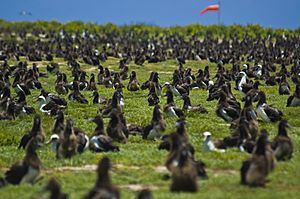
Midway Atoll is a very important place for seabirds. It is home to most of the world's Laysan Albatross population (67-70%). It also has a large part of the global Black-footed Albatross population (34-39%).
Nearly three million birds live on Midway. Each type of seabird has a specific place on the atoll where it builds its nest. There are 17 different kinds of seabirds found here. The rarest is the Short-tailed Albatross, also called the "Golden Gooney." Only about 2,200 of these birds exist today. This is because many were hunted for their feathers in the late 1800s.
The lagoon and surrounding waters cover about 300,000 acres. They are home to over 250 different kinds of marine life. The critically endangered Hawaiian monk seals raise their pups on the beaches. Monk seals find their food on the ocean floor, eating fish, squid, octopus, and crabs from Midway Atoll's reefs.
Green sea turtles, which are also a threatened species, sometimes nest on the island. The first one was seen in 2006, and another in 2007. A group of about 300 spinner dolphins lives in the lagoons and nearby waters.
Images for kids
See also
 In Spanish: Islas Midway para niños
In Spanish: Islas Midway para niños



